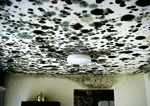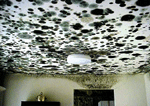
At Work and Home Exposures
- By John J. Heft
- Oct 16, 2009
Most people do not normally link environmental impairment to commercial or habitational real estate. Commercial property owners and contractors tend to believe that pollution conditions such as mold/microbial matter or lead-based paint are covered by general liability policies. They are not.

Scientific studies show that mold in the walls and ceiling of homes substantially raises the risk of asthma and other respiratory problems and adds $3.5 billion to the annual national health bill. Photo by Mike McNickle.
Over the past several years, exclusions for these conditions have appeared on general liability policies, creating coverage gaps for these potential lightning rods and other unknown historic pollution conditions such as dry cleaning solvents, which can affect soil and groundwater. This gap combined with the absolute or total pollution exclusion that has been a part of general liability policies since the late 1980s may now present numerous challenges to the balance sheets of both commercial and habitational property owners.
Consequently, uncovered claims can be significant as the following examples demonstrate:
- At a condominium complex in the Northeast, several people became ill, including a woman who died, from inhaling a water mist contaminated with legionella bacteria. In this case, the owner had to evacuate the entire complex, disinfect the water system, and following a lawsuit, address a seven-figure claim.
- In another case, a mall employee called 911 complaining of symptoms produced by an odorless, colorless gas. After the fire department arrived, eight people were treated with oxygen at a local hospital and then released. A chimney collapse caused carbon monoxide to enter the ventilation system. The mall had to be closed and several affected parties filed bodily injury claims that led to $250,000 in legal defense costs.
- The buyer of a strip shopping center discovered perchloroethylene (PCE)-contaminated soil and groundwater during capital improvement and expansion activities. A former dry cleaner had operated on site with the previous owner, who had the property for about five years. While the current owner conducted environmental due diligence prior to the acquisition, the Phase I Environmental Site Assessment did not identify a former dry cleaner at the property and failed to recognize the existence of potential pollutants and recommend a Phase II Environmental Site Assessment. Expansion activities ceased until all of the PCE-contaminated soil and groundwater was remediated for a total cost of nearly $1.2 million.In addition to those described above, the risks can be related construction debris containing hazardous materials; poor underground and aboveground tank management programs, resulting in surface and subsurface soil and groundwater contamination; hazardous chemical storage (maintenance degreasers, pool chemicals, pesticides and herbicides used both indoors and outdoors, etc.); lead, asbestos, polychlorinated biphenyls; and "midnight dumping" on vacant land parcels.
These risks have driven commercial and habitational real estate developers and owners to mitigate their exposures contractually, through environmental insurance, or both. Financial institutions protecting their investments and sellers who want to walk away free and clear from their properties also are driving the need for environmental insurance.

Finding lead paint in your property can be an expensive, unexpected cost.
At the top of the ($2.5 billion annual premium) environmental insurance provider market are Chartis Insurance (formally AIG), XL Capital, Zurich, ACE USA, and Chubb, which account for approximately 90 percent of the total premiums written. The remaining 10 percent that offer at least some form of environmental liability insurance include Liberty, Markel Underwriting Managers, American Safety, Freberg Environmental/Endurance and Great American. Other new market entrants are Navigators and Philadelphia Insurance Company.
Each environmental liability insurer offers its own manuscripted coverage forms and portfolio of environmental liability coverage (largest carrier offers up to 15 different coverage forms). One of the most widely used forms for commercial and habitational real estate is Premises Environmental Liability/ Pollution Legal Liability (PLL) insurance.
PLL covers pollution conditions or events on, at, under or migrating from a covered location(s), providing coverage for third-party bodily injury, property damage, clean-up costs and legal defense expense. A unique feature of many PLL policies is their ability to offer various and different coverage under one policy form. Such coverage includes but is not limited to non-owned disposal site, business interruption including loss of rental income, natural resource damages, automatic coverage for newly acquired properties, and divested/sold properties.
In addition, PLL serves as a risk management tool, reducing the uncertainty of liability, for commercial and habitational real estate. At a cost of pennies per square foot, PLL helps fill the “environmental gap” left in most general liability policies for property owners and facility or site operators. Programs can be tailored to address diverse needs and various requirements and objectives, including regulatory obligations, contract requirements, lender requirements, landlord obligations, and business objectives.
About the Author
John J. Heft is vice president and director- Real Estate Practice of New Day Underwriting Managers, LLC, a specialty resource for agents and brokers, assisting them and their clients find appropriate, high-quality environmental and construction related professional liability insurance coverage.